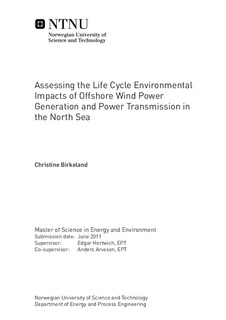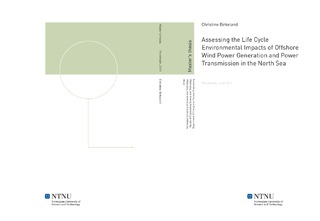| dc.description.abstract | An integrated approach to climate and energy policy is required to meet the challenges associated with climate changes caused by anthropogenic emissions. At the same time, the demand for electricity is increasing. Wind power is considered as part of the solution in solving these challenges, as this is renewable energy. By relocating wind power production offshore, stronger winds are achieved that increases electricity production without having emissions of GHG during power production. Europe's ambitious goals and plans for development of offshore wind power development in the North Sea have also raised questions about how to integrate wind power into existing power systems in Europe. In this study the environmental impacts of offshore wind power production and development of an offshore grid in the North Sea, have been considered. To quantify the environmental impacts associated with offshore wind power generation and power transmission in the North Sea, several LCA’s have been carried out. Four LCA's were conducted, whereof three of them were analyses of various submarine cables used either in offshore wind farms or long-distance power transmission. The cables studied were; 33 kV HVAC cables used internally in offshore wind farms, 132 kV HVAC cables used to transmit power from a wind farm to the grid onshore and 450 kV HVDC cables used for long-distance power transmission between for instance countries. A fourth LCA was conducted of an entire offshore wind farm, including the inventories of the 33 kV and 132 kV cables. The emissions from a 390 MW offshore wind farm with bottom-fixed windmills, were calculated to be 20.6 g CO2 -equivalents/kWhel. Cabling constituted only 1.5 % of the total impacts to climate change from the wind farm. A larger wind farm of 9000 MW had lower estimated emissions of 19.8 g CO2 -equivalents/kWhel due to a higher electricity production. The LCA results of the 450 kV cables were used in estimating the environmental impact caused by different designs of offshore power grids in the North Sea. Several alternative grids were investigated, both with and without wind farms. For instance, a power grid in the North Sea where the two wind farms above were implemented, had estimated emissions of 84 million tonnes of CO2-equivalents throughout lifetime. This represents approximately 2% of the EU-27 countries' total GHG emissions from 2007. In addition to the quantification of environmental impacts, a qualitative discussion was conducted of the various environmental costs and benefits associated with large-scale development of power generation and transmission in the North Sea. The results from this study indicate that the expected environmental impacts from developing offshore wind farms and power grids in the North Sea are not insignificant. The positive environmental effects are large because the increased transmission capacity between power markets allows for increased development of electricity generation from intermittent renewable energy sources like wind power. Increased share of renewable energy reduces the need for power generation from fossil fuels, thus there will be an environmental gain. The study seeks to emphasize the complexity and the important aspects of the assessment of environmental impacts associated with large power systems. | nb_NO |

